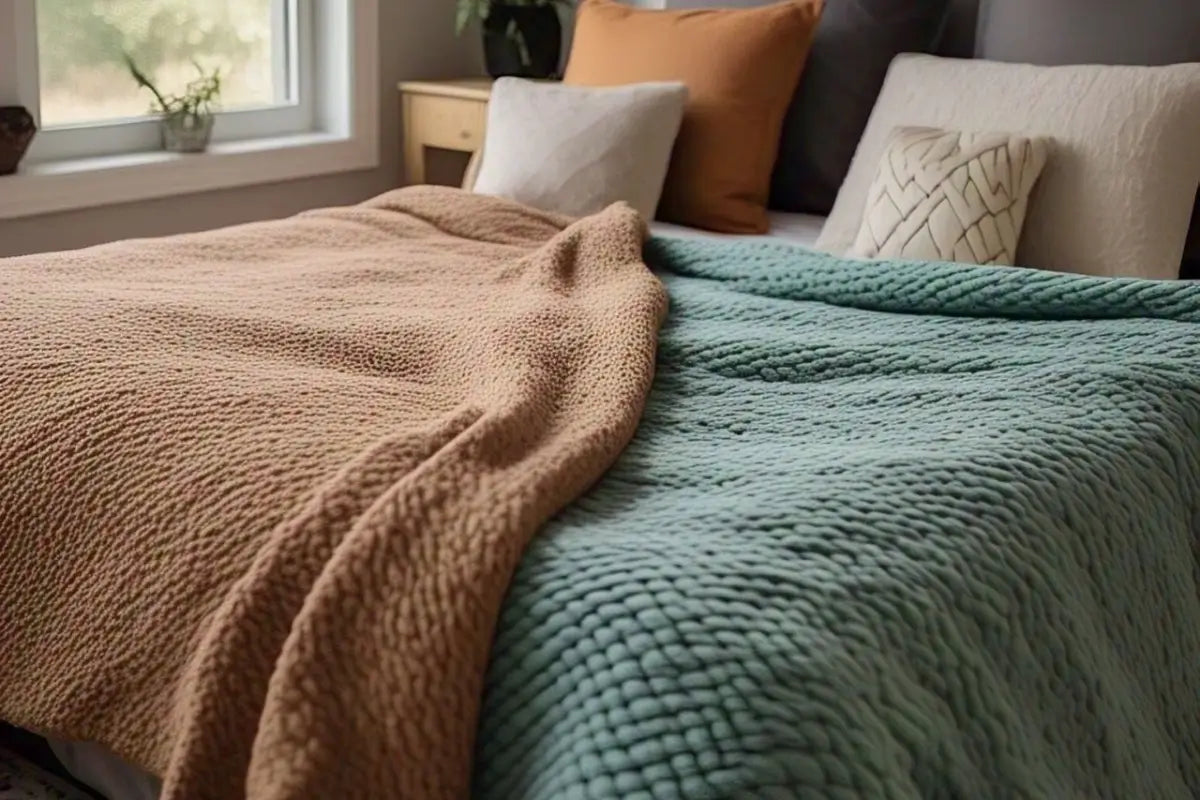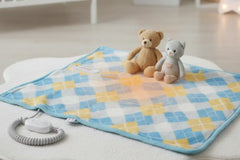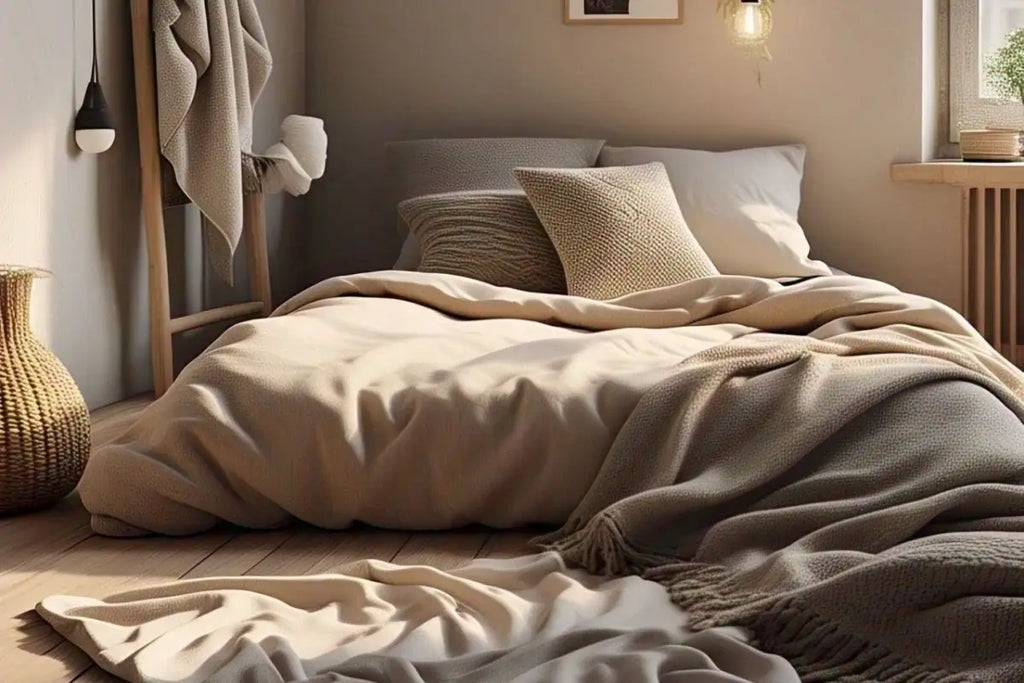Weighted Blanket Materials: Organic vs. Synthetic

Table of contents
Struggling to choose between organic and synthetic weighted blankets? The wrong material can lead to overheating, irritation, or even exposure to harmful chemicals.
Imagine tossing and turning, feeling discomfort instead of relaxation. But don't worry, understanding the pros and cons of each option helps you find the perfect blanket for restful sleep. Let’s explore the best choice for you!
Key Takeaways:
-
Choose Breathable Fabrics: Cotton and bamboo keep you cool and comfortable.
-
Prioritize Warmth or Softness: Minky and fleece provide extra coziness.
-
Pick the Right Filler: Glass beads offer even weight, while plastic pellets are budget-friendly.
-
Ensure Safety and Durability: Organic fabrics are chemical-free, while synthetic options last longer.
-
Follow Proper Care: Use gentle detergent, cold water, and air-dry for longevity.
-
Use a Duvet Cover: It keeps your blanket clean and reduces washing frequency.
Understanding Weighted Blanket Materials
Weighted blankets come in various materials, each offering unique benefits. Cotton and bamboo enhance breathability, while minky and fleece add warmth.
Glass beads provide even weight distribution, while plastic poly pellets offer a budget-friendly alternative.
Choosing the right combination of fabric and filling ensures a comfortable experience tailored to individual needs.
Popular Materials Used in Weighted Blankets
Cotton for Breathability and Softness
Cotton is a favorite for its softness and breathability. It allows air to circulate, making it a great choice for hot sleepers.
Natural cotton wicks away moisture, keeping the blanket comfortable throughout the night. Its durability and ease of care make it a practical option for daily use.
Minky Fabric for a Luxurious Feel
Minky fabric is ultra-soft, offering a plush, velvety texture. It adds warmth, making it ideal for cooler nights.
Many prefer minky for its cozy, comforting feel, especially when seeking extra snuggle factor.
Bamboo for a Cooling Effect
Bamboo fabric is ideal for those who sleep hot. It absorbs moisture better than cotton, keeping sleepers dry and cool.
This eco-friendly material is also hypoallergenic and antimicrobial, making it a great option for sensitive skin.
Fleece for Warmth and Comfort
Fleece is known for its warmth, making it a great choice for colder climates. It retains body heat effectively but is less breathable than natural fibers. Its soft texture enhances comfort, especially in winter months.
Glass Beads for Even Weight Distribution
Glass beads are the preferred filler for weighted blankets because they offer a smooth, even weight.
They remain in place, reducing shifting over time. Their small size allows for a thinner, quieter blanket compared to plastic pellets.
Plastic Poly Pellets for Affordability
Plastic poly pellets are a budget-friendly filler option. While they provide effective weight, they can be bulkier and create uneven pockets.
They work well for those looking for an economical choice without compromising too much on function.
Microfiber for Durability and Easy Maintenance
Microfiber is one of the most durable options available. Unlike cotton, it holds up well in the wash and resists shrinking or fading. Its smooth texture makes it comfortable, and its longevity ensures a lasting investment.
Organic vs. Synthetic Fabrics: What’s the Difference?
-
Organic Fabrics (Cotton & Bamboo)
Eco-friendly and chemical-free
Breathable and soft
May require more care
-
Synthetic Fabrics (Polyester)
Longer-lasting and durable
Resists wear and tear
Tends to trap heat
-
Choosing Between Organic & Synthetic
Based on personal preference
Depends on comfort needs

How Filling Materials Affect Weighted Blankets
The filling inside a weighted blanket decides how evenly the weight spreads across your body.
Glass beads and micro steel beads settle smoothly, preventing uncomfortable lumps, while plastic pellets can shift and create uneven pockets.
Size also matters—smaller beads feel softer and mold better to your shape, while larger fillings may feel bulkier.
If you overheat easily, glass beads regulate temperature best, while plastic and sand retain more heat. Over time, some fillings break down, leading to clumping or leaks, affecting durability.
Choosing high-quality materials ensures a soft, evenly distributed weight that stays comfortable for years.
Do Blanket Materials Affect Sleep Quality?
The right blanket material can significantly impact sleep quality. Breathable fabrics like cotton and bamboo promote airflow, while warmer materials like fleece and minky provide coziness.
Weight distribution also affects relaxation, making it essential to choose a material that supports your sleep needs.
For example, a study found that weighted blankets improved sleep quality and reduced insomnia symptoms among adults with clinical insomnia.
Participants using weighted blankets showed greater improvements in sleep quality, stress, and fatigue compared to those with normal blankets.

How Fabric and Filling Impact Weight Distribution
The fabric and filling play a crucial role in how evenly the weight spreads across the body.
Dense materials and high-quality fillers help maintain balance, while lighter, slippery fabrics may cause shifting. Selecting the right combination ensures consistent pressure and comfort.
Are All Weighted Blanket Materials Safe?
Not all weighted blanket materials are equally safe. Some contain synthetic fillers that may release harmful chemicals, while others use organic, non-toxic materials.
To avoid allergic reactions, it's best to choose hypoallergenic fabrics like organic cotton or bamboo.
Certain blankets may also contain dyes or treatments that can cause skin irritation, so checking for chemical-free options is important.
BPA-free blankets are generally safer, but it's still crucial to look for certifications like OEKO-TEX, which ensures materials are free from harmful substances.
Always check labels and certifications to make sure your weighted blanket is safe for long-term use.
Which Fabrics Last the Longest?
When it comes to durability, microfiber and polyester blends stand out as the toughest weighted blanket fabrics, resisting wear and tear better than most natural options.
Synthetic fabrics generally last longer than organic ones because they resist shrinking, pilling, and fading over time.
However, high-quality natural fabrics like organic cotton and bamboo can still hold up well, especially when properly cared for.
Bamboo, in particular, is known for its strength and softness, making it a great alternative to synthetic materials.
For longevity, tightly woven fabrics and those that withstand frequent washing, like microfiber and durable cotton blends, are the best choices.
How to Clean and Care for Weighted Blankets
Check the Care Label First
Before washing a weighted blanket, always check the care label. This small tag contains essential instructions, including water temperature, drying methods, and whether machine washing is safe.
Not all weighted blankets have the same cleaning requirements because different materials and fillings react differently to water and detergent.
Common washing symbols on care labels indicate whether to use cold or warm water, gentle cycles, or air drying.
If your care label is missing, look up the manufacturer’s guidelines or opt for the most delicate cleaning method to avoid damage.
Use a Gentle Detergent
A mild detergent protects both the fabric and the weighted filling inside your blanket.
Harsh chemicals can break down fibers and weaken the structure, leading to wear and tear over time.
Avoid detergents with bleach, fabric softeners, or strong fragrances, as they may cause residue buildup.
Gentle, dye-free detergents designed for delicate fabrics work best. If you need to remove stains, a mild detergent combined with a bit of white vinegar or baking soda can be effective.
Diluting detergent before use also helps prevent soap buildup and ensures a thorough, gentle clean.
Wash in Cold or Warm Water
Cold or warm water is ideal for washing a weighted blanket because it prevents fabric shrinkage and protects the internal filling.
Hot water can break down delicate fibers, weaken stitching, and affect the weight distribution inside the blanket.
Warm water helps lift stains without causing damage, especially when paired with a gentle cycle.
Always follow the care label’s instructions regarding temperature. Using a mild detergent and avoiding high heat will help extend the life of your blanket, keeping it soft and comfortable over time.
Choose the Right Washing Method
Machine washing is suitable for many weighted blankets, but some require hand washing or professional care.
Check the weight limit of your washing machine before loading the blanket to prevent damage.
If the blanket has a removable cover, wash it separately. Hand washing is a good alternative for blankets with delicate fabrics or natural fillers like glass beads.
If your blanket is labeled dry-clean only, take it to a professional cleaner. When in doubt, washing in cold water on a gentle cycle with mild detergent is the safest approach.
Avoid Fabric Softeners and Bleach
Fabric softeners may leave a residue on weighted blankets, making them feel less breathable and reducing their softness over time.
These products can also break down the fibers and affect the filling’s integrity. Bleach is even more damaging, as it can cause fading, weaken the material, and alter the texture.
To remove stains safely, use a mixture of water and mild detergent or apply a bit of baking soda with a damp cloth.
Vinegar can also be an effective natural alternative for eliminating odors without harming the fabric.
Dry Properly
Air-drying is the best method for preserving a weighted blanket’s structure, especially if it contains glass beads or organic fillers.
If using a dryer, select a low heat or tumble dry setting to prevent overheating. To avoid clumping, periodically fluff and shake the blanket while drying.
Laying it flat on a clean surface ensures even drying and helps maintain its shape.
Flipping the blanket occasionally speeds up drying time. If needed, place dry towels in the dryer with the blanket to help absorb moisture and reduce drying time.
Spot Clean Small Stains
For minor stains, spot cleaning is the easiest way to keep your weighted blanket fresh without a full wash.
Use a damp cloth with mild detergent to gently blot the affected area. Avoid scrubbing, as it can push stains deeper into the fabric.
Natural stain removers like vinegar or baking soda can help lift tough spots without harsh chemicals.
Cold water works best for preventing stains from setting, while warm water can help loosen oily stains.
After cleaning, blot with a dry towel to remove excess moisture and prevent water rings.
Store It Correctly
Proper storage keeps your weighted blanket in top condition when not in use. Fold or roll it neatly to prevent creases, and store it in a breathable fabric bag to protect against dust and moisture.
Avoid plastic bags, as they can trap humidity and lead to mildew. Store the blanket in a cool, dry place to prevent odors or mold growth.
If you have a heavy blanket with bead fillings, ensure it’s stored flat to maintain even weight distribution. Proper storage helps extend its lifespan and keeps it fresh for future use.
Shake and Fluff Regularly
Regularly shaking and fluffing your weighted blanket helps maintain its even weight distribution. Over time, the filling may shift, creating uneven pressure.
A quick shake every few days helps keep the materials evenly spread. If left unshaken for too long, the filling may clump together, reducing its effectiveness.
Fluffing also helps restore softness and comfort. Make it a habit to shake and spread out the blanket after each use to prevent lumping and ensure consistent weight distribution for better relaxation and sleep.
Use a Duvet Cover
A duvet cover acts as a protective layer, keeping your weighted blanket clean while reducing the need for frequent washing.
This simple addition prevents dust, dirt, and sweat from reaching the blanket’s inner layers.
It also makes cleaning easier since duvet covers are machine washable and dry quickly.
Choose a breathable, soft fabric for added comfort. To keep the cover in place, secure it with ties or zippers.
Washing the cover weekly or biweekly maintains hygiene while extending the life of your weighted blanket.

Do Some Fabrics Make Weighted Blankets Noisy?
Some fabrics make weighted blankets quieter than others, creating a more peaceful sleep experience.
Minky fabric, with its plush texture, barely makes a sound, making it one of the quietest options.
Cotton, while breathable and soft, can produce slight rustling, especially if paired with certain fillings.
Bamboo fabric is another silent choice, offering a smooth, fluid feel that reduces noise.
Flannel, with its slightly thicker weave, absorbs sound better than crisp cotton, adding to its quiet nature.
In general, smoother fabrics like silk or microfiber help minimize noise, ensuring that every movement remains undisturbed throughout the night.
Choosing the Right Material for Your Needs Weighted Blanket
Choosing the right material for your weighted blanket makes a big difference in comfort and effectiveness.
Cotton, bamboo, fleece, and microfiber are the most common options. Cotton and bamboo stand out for their breathability, making them great for year-round use.
Bamboo wicks moisture away, while cotton feels soft and natural. If you have sensitive skin, organic cotton is a gentle choice, free from harsh chemicals.
For allergy sufferers, hypoallergenic materials like bamboo or OEKO-TEX-certified cotton reduce irritation.
The fabric also affects weight distribution—light, breathable fabrics create a soothing feel, while plush options add warmth. Finding the right material ensures ultimate comfort.
FAQs
Do Different Weighted Blanket Materials Affect Sleep Position Comfort?
Different weighted blanket materials affect comfort in various sleep positions. Side sleepers benefit from soft, flexible fabrics like cotton or fleece that mold to the body without excessive pressure on shoulders and hips. Back sleepers typically prefer cotton for even weight distribution and breathability. Stomach sleepers may favor bamboo fabric for its lightweight, breathable properties. Plush or fleece materials provide warmth but may feel too heavy for stomach sleepers. Smooth fabrics allow easier movement, while rougher textures can restrict adjustments. The right material enhances comfort and supports spinal alignment.
Are Weighted Blankets Made from Sustainable Materials as Effective as Traditional Ones?
Sustainable weighted blankets offer the same comfort and deep-pressure stimulation as traditional ones. Organic materials like cotton and bamboo are soft, breathable, and regulate temperature well. Fillings such as glass beads or natural grains distribute weight evenly for a calming effect. While durability varies, sustainable options provide comfort and eco-friendliness.
How Do Different Weighted Blanket Fabrics Handle Temperature Regulation?
Different fabrics in weighted blankets affect temperature regulation. Cotton and bamboo allow airflow and wick moisture, keeping you cool, while polyester traps heat and is less breathable. In summer, bamboo and lightweight cotton are best for releasing heat. Organic fabrics generally offer better breathability and moisture control than synthetics. Cotton provides more ventilation, while synthetics can feel stuffy. Choosing the right material is key to staying comfortable.
Can the Material of a Weighted Blanket Affect Its Noise Level During Movement?
The material of a weighted blanket affects how much noise it makes when you move. Softer, thicker fabrics like cotton and bamboo are quieter than thin synthetics like polyester, which can crinkle. Bamboo-based blankets are especially smooth and silent, ideal for light sleepers. The filling also matters. Plastic pellets are noisier than glass beads, which move more smoothly. Micro glass beads are even quieter due to less friction. The right fabric and filling can make a weighted blanket nearly soundless.





